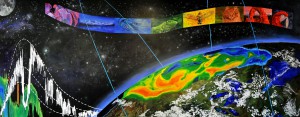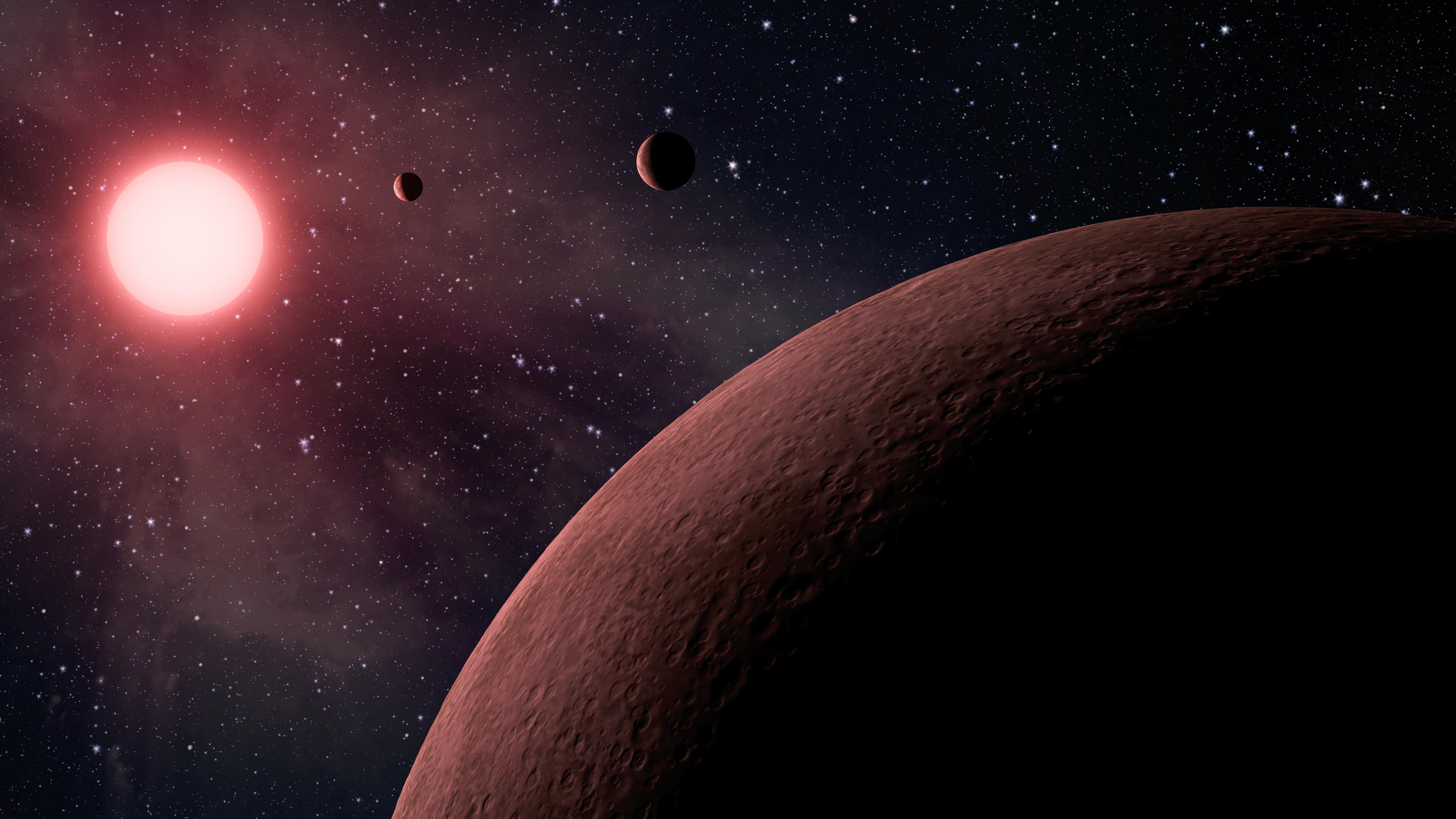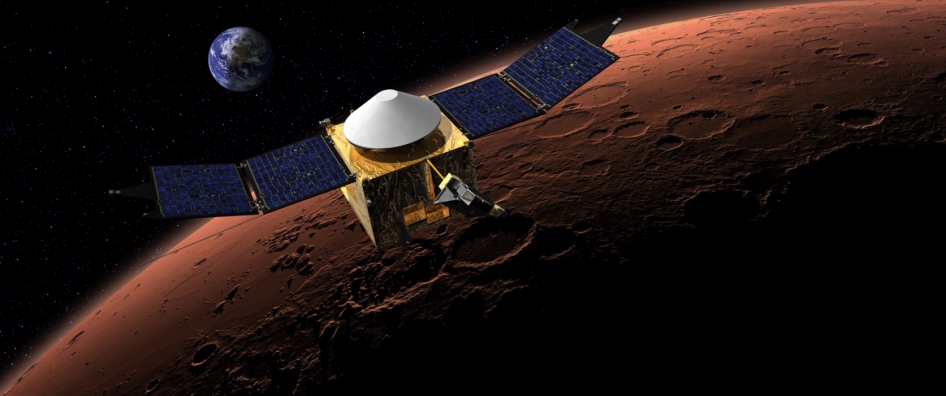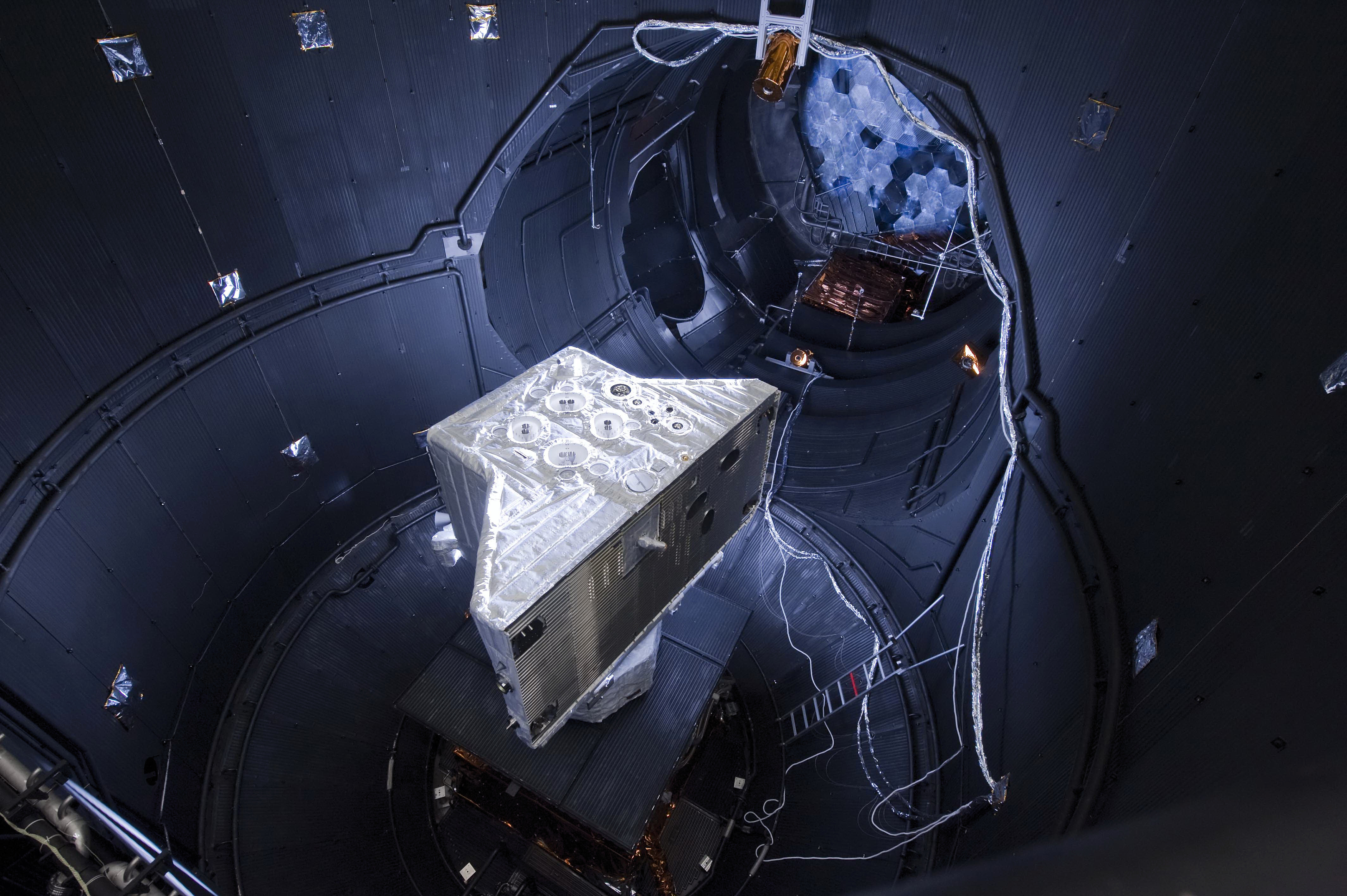
By David Young
CLARREO, the Climate Absolute Radiance and Refractivity Observatory, is an Earth-science satellite mission in pre-Phase A (conceptual study) that is being designed to capture critical climate-change data much more precisely than has been possible with existing instruments.

A mural painted by summer student Amanda Cichoracki to represent CLARREO’s mission.
Photo Credit: NASA Langley Research Center/David Beals
Its spectrometers, sensitive to the full range of infrared and visible radiation, will improve the accuracy of measurements of all the radiation leaving Earth by a factor of two to ten. That accuracy and the mission’s ability to measure trends over a decade or more could help scientists know whether climate change will be less or more severe than expected as much as two decades earlier than current data allow. This could be a key determinant for decisions concerning our nations response to changes in climate.
So its not surprising that the 2007 decadal survey of “Earth Science and Applications from Space” considered CLARREO one of four high-priority Earth-science missions. In response to the survey, a small team of scientists was formed at Langley Research Center to define the mission. In early 2009, we gathered a full-fledged preformulation team including scientists, systems analysts, discipline engineers, and business analysts at Langley along with smaller teams at Goddard Space Flight Center and the Jet Propulsion Laboratory and about ten external organizations with the goal of developing a feasible concept for CLARREO.
Bringing the Team Together
Having worked on other NASA science missions, including CERES (Clouds and the Earths Radiant Energy System) and CALIPSO (Cloud-Aerosol Lidar and Infrared Pathfinder Satellite Observations), mission scientist Bruce Wielicki, mission formulation manager Steve Sandford, and I were well aware of a familiar pitfall—that the CLARREO scientists would want only the best possible data regardless of the practical difficulties involved in getting it. That would lead to time-consuming and potentially acrimonious trade talks when scientific desires came up against engineering and budget realities. To avoid that kind of problem, we were determined to bring the team together early and make the science and engineering decisions part of one discussion, not two. From the outset, the management team had a vision of forming a truly interdisciplinary team that involved systems thinking at all levels.

This global map shows temperature anomalies for July 4–11, 2010, compared with temperatures for the same dates from 2000 to 2008. CLARREO’s ability to measure trends over a decade or more could help scientists know whether climate change will be less or more severe than expected as much as two decades earlier than current data allow.
Image Credit: Jesse Allen, based on MODIS land-surface temperature data available through the NASA Earth Observations web site.
We began by holding a two-day off-site retreat, facilitated by 4-D team-assessment experts. The 4-D Systems approach focuses on critical “soft skills” for scientists, engineers, and project leaders. The retreat included some typical team-building activities, such as people talking about their backgrounds to get to know one another, but most of the team building came from doing actual project work: establishing a clear shared vision of the mission, defining roles and responsibilities, and dealing with bottlenecks that had already become evident by diffusing authority that was concentrated in one overworked individual. The 4-D facilitators also provided the team with training that helped us appreciate the benefits of continual engagement across the diverse skills of the team.
Back at Langley, the entire team was collocated in an open area that had once been a cafeteria. There were no closed offices, only cubicles and multiple meeting areas, so everyone was aware of what his or her colleagues were doing. The project leaders worked in cubicles, too, and were always accessible. We had not only an open-door policy, we had a no-door policy. This resulted in a dynamic, collaborative environment that furthered the bonding process that started at the retreat.
Although at times noisy and a bit chaotic, this arrangement made it easy to join in conversations and address issues as they arose. On multiple occasions, I was able to quickly provide clarification of technical aspects of the science in response to conversations in our break room. We encouraged systems thinking by including science and engineering representatives at almost every technical meeting. Communication was further enhanced through daily, early-morning, stand-up meetings to share late-breaking news and set daily priorities.
Our integration initiatives went beyond the Langley team. Internal and external science team members participated in weekly telecons in the first year as scientific goals and priorities were clarified. We also worked actively to bridge the common gap between scientist-observationalists, who focused on how to gather data, and the data users, who wanted the best possible data and didn’t give much thought to issues related to the instruments that would gather it. We brought several teams of global climate modelers who would be the primary CLARREO data users into our requirements planning from day one. That has led to the development and use of innovative climate-observing system-simulation experiments that have not only demonstrated the utility of CLARREO data for improving climate predictions, but have been essential in setting rigorous accuracy requirements for the measurements.
The Science-Value Matrix
The most significant result of our integrated approach has been the development of the science-value matrix (SVM). This tool has helped clarify our trade discussions and weigh scientific value against cost, risk, and reliability as fully and objectively as possible. Like other work on CLARREO, developing the science-value matrix was a cooperative team effort.
The relative merits of competing goals are difficult to quantify for a complex mission with multiple science objectives. This is particularly true for a mission like CLARREO, where the measurements are applicable to a wide range of climate objectives. Without an objective means of calculating science benefit, our team could not effectively evaluate the relative costs and benefits of multiple engineering approaches. We met this challenge by developing the SVM: an innovative approach to quantitatively defining science value for key aspects of the mission, including measurement accuracy, orbit type, and record length. Benefits were measured based on the specific advances that CLARREO would provide in reducing uncertainties in the climate observations as defined by the Intergovernmental Panel for Climate Change. By rigorously defining relative science value across the broad climate objectives of CLARREO, the team provided a mechanism for optimizing science value relative to cost for a broad range of potential mission architectures.
We had not only an open-door policy, we had a no-door policy. This resulted in a dynamic, collaborative environment the furthered the bonding process that started at the retreat.
The SVM was also designed to be a management tool to be used over the projects life cycle. The matrix grounded and shaped discussions in objective fact and helped avoid what could otherwise easily have become formless, inconclusive debates. It definitely helped us guard against mission creep—the temptation to add just one more capability that could quickly lead to losing control of budget and schedule.
For instance, members of our external science team advocated the addition of a polarimeter that would use the polarization of light to analyze aerosols (particles suspended in the atmosphere) to CLARREO’s instruments. They wrote a peer-reviewed paper arguing for the instrument. In fact, it would have been a potentially great addition, since aerosols influence the amounts of absorbed and reflected radiation. The question was, how would that added value compared to the added cost? The SVM allowed us to determine that a polarimeter would give us 30 percent added value but would raise the cost by 30 percent as well. Headquarters agreed that the instrument was a great idea but decided it was a great idea we couldn’t afford within the CLARREO project.
The Future of CLARREO
The CLARREO team successfully passed its mission concept review in November 2010. The effectiveness of team integration was confirmed by the review panels board chair, who cited the exceptional working relationship among science, project management, and engineering as a major strength of the project, leading to a mission concept that was extremely mature for that project stage. Due to budget considerations, CLARREO remains in an extended pre-Phase A.
NASA continues to fund efforts to refine the mission design and to look for cost-effective alternative ways to carry it out. For instance, we are examining the possibility of putting the instruments on the International Space Station instead of on their own satellite observatories. We have also been working on a study with a group in the United Kingdom, exploring possibilities for international partnering. And we are using the science-value matrix to search for a less expensive way to achieve the missions science goals, perhaps with less capable but still adequate instruments.
The budget constraints are challenging, but we remain committed to this critical climate mission. This team experience has been one of the most rewarding of my career, and I believe that the trust and cooperative spirit the CLARREO team has developed in our years together will help us succeed despite these challenges.
About the Author
 David Young is the project scientist for CLARREO at Langley Research Center, where he has been working for more than thirty years to help understand Earths climate. He currently serves as the deputy for programs in the Langley Engineering Directorate. David Young is the project scientist for CLARREO at Langley Research Center, where he has been working for more than thirty years to help understand Earths climate. He currently serves as the deputy for programs in the Langley Engineering Directorate. |








